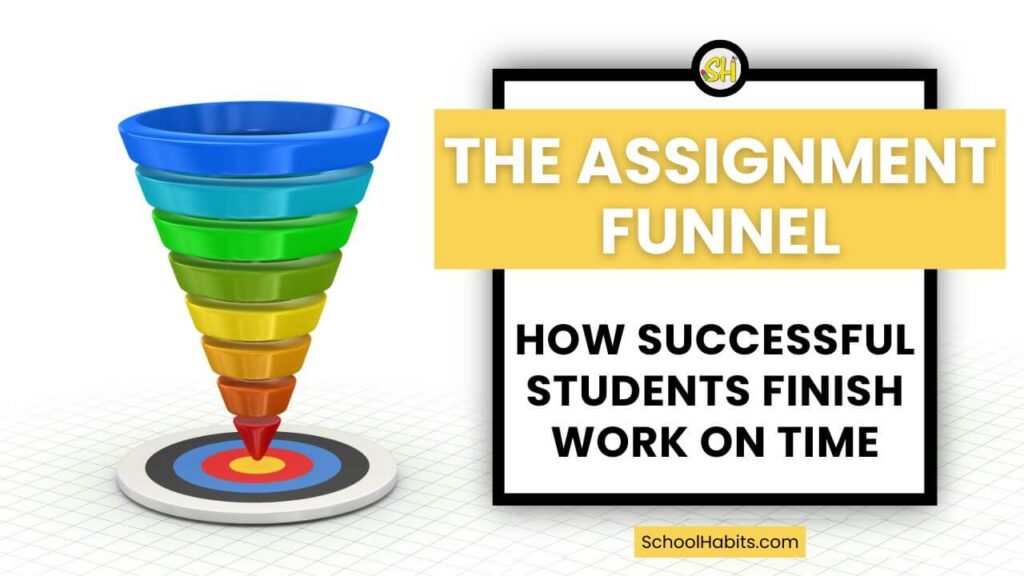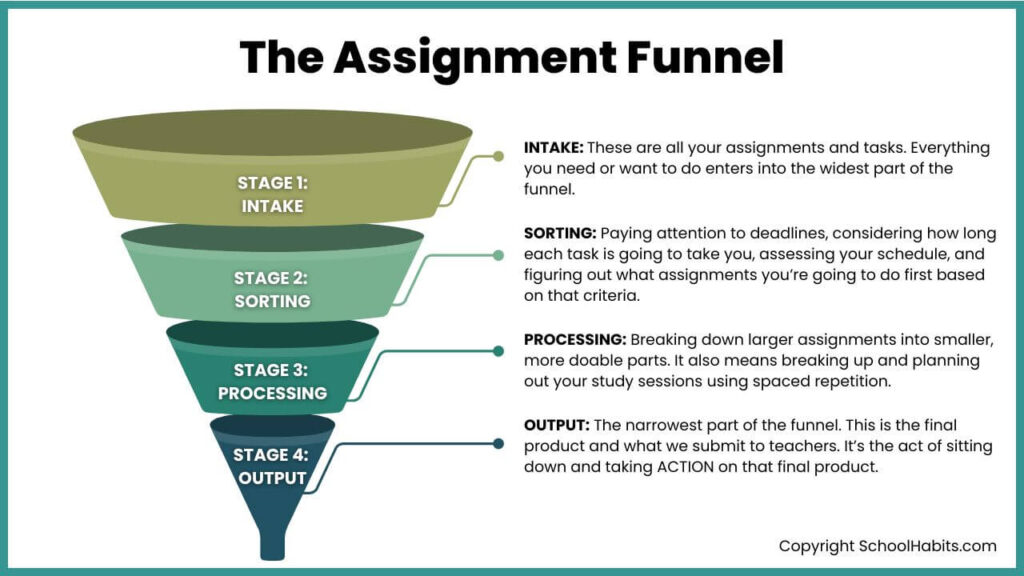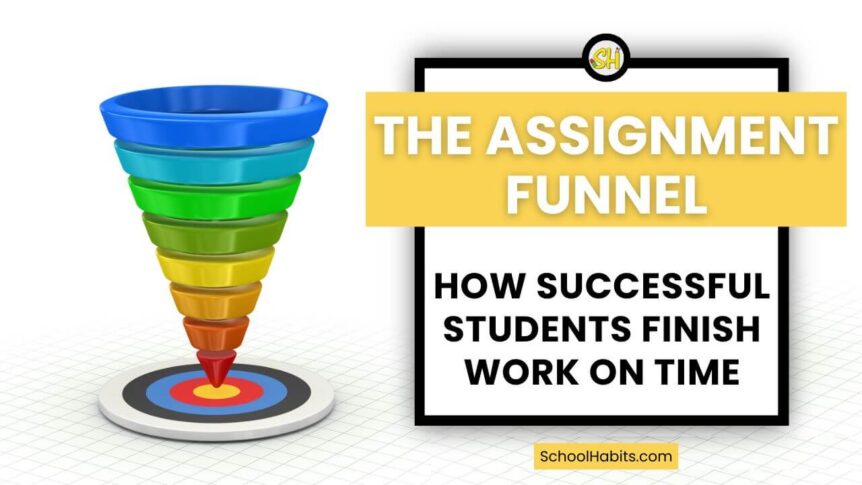
By Katie Azevedo, M.Ed.
There’s more to completing a single homework assignment than just sitting down and doing it. To complete a homework assignment from start to finish, and turn it in on time, four separate things need to happen.
If there is a bottleneck or disruption in any of these four steps, your assignment won’t get done, it’ll be rushed at the last minute, or it’ll be late.
In this blog post, I’m going to teach you about the Assignment Funnel. I’m going to expose those four steps that need to happen for you to get any assignment done on time.
The information I share in this post is true whether you’re a student in middle school, you’re working toward a PhD, or you’re a working professional.
Introduction to the Assignment Funnel
Picture this: On Monday, a teacher assigns a research paper due in three weeks.
Student A: hears “paper due in three weeks” and somehow manages to panic-write it and turn it in at 11:59 the night before.
Student B: hears “paper due in three weeks” and gets it done and turns it in the day before it’s due without any panic or drama.
So what’s happening here?
I’ll give you a hint: it has nothing to do with how smart the students are or how busy or not busy they are. In fact, let’s assume that Student A and Student B have the exact same amount of free space in their schedules to work on the paper.
The answer comes down to the Assignment Funnel. Student A has some kind of block or kink somewhere in their funnel.
On the other hand, student B has a smooth Assignment Funnel from top to bottom.
What Is An Assignment Funnel?
An Assignment Funnel is the mental and organizational systems that move your work from assigned to in progress to done without any bottlenecks in the progression.
Picture it like a kitchen funnel. A kitchen funnel is wide at the top and allows everything in (all your tasks and assignments). It narrows at the bottom, indicating that only what is completed can leave the funnel.
Students who regularly complete work on time have a clear, unclogged Assignment Funnel.
Conversely, students who struggle to complete and turn in work on time often have an invisible bottleneck somewhere along the four stages of their Assignment Funnel.

The 4 Stages of the Assignment Funnel
An Assignment Funnel has four key stages. We’re going to talk about each one below. Some students consistently get blocked in one of the four stages, while other students can get blocked at any stage, depending on the assignment and the circumstances.
Stage One: Intake
This is the top of the funnel. It’s the widest part. Intake is how you capture new assignments the moment you get them.
I have an absurdly large number of tutorials teaching you how to build systems for tracking homework. This is called task management. I also talk about this in my podcast. I will link the relevant podcast episode below.
But the place where I dive the deepest and give the clearest step-by-step instructions for building a task management system to optimize your intake is inside SchoolHabits University.
Long story short: you have to have a way to track and capture the tasks you’re expected to do. If you don’t do this, your funnel is broken from step one.
Students, this is not your learning management system. What your teachers post to Google Classroom or whatever you’re using does not cover even a fraction of what you’re supposed to do for school.
Let me repeat: your learning management system is not a task management system. If you are using your learning management system as your intake system, this is where your bottleneck is.
Also, if you try to keep all your assignments in your head, despite approximately 9 billion studies that prove the cognitive ridiculousness of that strategy, then you have a bottleneck at stage one.
Stage 2: Sorting
The second stage of the funnel is sorting. You could also call this prioritization. This is the process of assessing all of the assignments that come through the top of your funnel and figuring out the order you’re going to do them.
Sorting involves paying attention to deadlines, considering how long each task is going to take you, assessing your schedule, and essentially figuring out what assignments you’re going to do first based on that criteria.
Students who struggle to prioritize often have a bottleneck at this step.
Students with anxiety also often have a bottleneck at this step because anxiety can lead to catastrophic thinking, which makes one believe that everything is important and urgent all at once.
In this blog post here I teach you how to figure out what assignments to do first.
Stage Three: Processing
Processing means breaking down your larger assignments into smaller, more doable parts. It also means breaking up and planning out your study sessions using spaced repetition instead of a non-functional five-hour study session the night before the test.
For example, if you were to “process” a research paper like the one we are pretending your teacher assigned on Monday, that would involve thinking about all the micro steps involved with that research paper and planning when you’re going to do each one. You might break down your research paper into the following steps:
- Do research
- Collect sources and evidence
- Outline paper
- Write first draft
- Edit
Many of the above steps could also be broken down further, as you’re not likely to sit down and write your entire research paper in one sitting (step 4).
But it’s this “processing“ that allows you to complete assignments at a reasonable pace over a reasonable amount of time without losing your mind.
If there’s a bottleneck in the processing stage of your Assignment Funnel, you’re probably trying to sit down and write the whole dang research paper at once. And then you wonder why it doesn’t come out well … or doesn’t come out at all.
If that sounds like you, focus on the skill of breaking down long-term assignments into smaller projects. It’s also time to accept that spaced repetition is the ultimate way to study.
And yes, I teach both of these skills inside SchoolHabits University.
Stage 4: Output
The narrowest part of our funnel is the output. This is the final product and what we submit to our teachers. But even before that, it includes the act of sitting down and working on that final product.
In the processing step, we are just breaking down assignments and projects into smaller steps and figuring out where those are going to live on our calendar. But output involves taking action on those plans and doing the work.
Professional procrastinators sometimes move through stages one through four just fine, but get stuck at stage five when they don’t do the work.
Other students try to bypass stages one through four and jump right into the work, which also backfires because you may not even know what you’re working on, you might’ve prioritized it wrong, and you might be trying to do too much in one sitting.
Note: If any one of these stages is missing or messy, the funnel backs up and you miss your deadlines.
I want you to picture that kitchen funnel again. If you never sit down and actually do your work, nothing leaves the funnel, right? That means things are going to continue pouring into your funnel because teachers are going to continue assigning work, but that funnel will soon overflow because nothing is moving through it.
It’s the overflowing of tasks from the top of the funnel that looks like panic, anxiety, overwhelm, paralysis, and incomplete or bad grades.
If you struggle to do the work because it’s hard, use these strategies.
Common Bottlenecks That Slow Students Down
I touched on a few common bottlenecks already, but I want to draw attention to a couple more. Your Assignment Funnel could use some tweaking if any of the following are true:
- You try to keep assignments in your head.
- You overestimate how much can fit into the “processing” stage at the last minute.
- You avoid starting work because the first step isn’t clear to you.
- You don’t account for other commitments filling the funnel at the same time (sports, jobs, volunteering, meetings, etc.)
- Assignments move backwards (get “stuck” in intake) because there’s no follow-through system.
- You continue to assume that the trouble you’re having submitting assignments on time is the teachers’ fault or school’s fault … but not your own. (It’s not your fault that it’s your fault (ha), because it’s not your fault that nobody ever taught you this process. But it will be your fault if you learn this process and don’t do anything about it.)
Why the Assignment Funnel Matters (Beyond Finishing Work on Time)
A clean Assignment Funnel means less mental clutter, lower stress, and better quality work.
The funnel is a skill system. Once you can create and run it for schoolwork, you can use it for jobs, internships, and life projects.
This is why completing work on time is not about “time management” alone: it’s about information flow management, and that’s a skill that you’ll need in every context of your life.
You can absolutely build your own Assignment Funnel from scratch, but it’s not something most schools ever teach you. That’s why in SchoolHabits University, I walk you through exactly how to set up and maintain the kind of systems that keep your funnel clear and your deadlines easy to hit, even when school feels wild.

